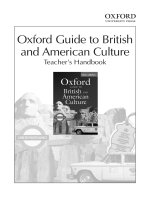Received Pronunciation And Cockney English In British English Thuyết trình môn Đa dạng Tiếng Anh
Bạn đang xem bản rút gọn của tài liệu. Xem và tải ngay bản đầy đủ của tài liệu tại đây (1.59 MB, 25 trang )
Received Pronunciation And
Cockney English In British English
GROUP 3
Nguyễn Vy Uyển Thanh
Nguyễn Phương Thảo
Huỳnh Thị Tường Vy
Nguyễn Thị Anh Thư
Hoàng Bảo Trân
Receive
Pronunciation
(RP)
Introduction of RP
- Received pronunciation, or RP,
refers to an accent in English
regarded by many people as a
‘standard' accent. It has also been
called ‘the Queen's English' or ‘BBC
English’.
• - “Received” means that this
pronunciation is accepted, or
adopted by British society.
• - It is widely for teaching English
as a foreign language.
•
History of RP
- It was introduced in British public shools in the 19th
century
- The concept of Received Pronunciation was
developed by Daniel Jones (1881–1967),
- After the phonetician Daniel Jones has used RP for
the second edition of the “English pronouncing
dictionary (1924), it became an accent of social elite
=> RP became a synonym of high class, social
prestige, and superiority for its speaker
- Today, 2-3% of UK population speaks with RP: Kate
Middelton, Emma Watson, etc
Characteristics
of RP
1.
2.
3.
4.
Yod-dropping
Non-rhotic
Intrusive /r/
Vowels
Yod-dropping
RP does not have yod-dropping (j) after /n/, /t/, /d/, /z/ and /θ/
new, tune, dune, resume
and enthusiasm are
pronounced /njuː/, /tjuːn/
, /djuːn/, /rɪˈzjuːm/ and /ɪ
nˈθjuːziæzm/ (RP)
new, tune, dune, resume
and enthusiasm are
pronounced /nuː/, /tuːn/,
/duːn/, /rɪˈzuːm/ and /ɪnˈ
θuːziæzm/ (GA)
Non-rhotic
RP is a non-rhotic accent, so /r/ does not occur unless followed
immediately by a vowel
court
hard
car
Receive
Pronunciation
kɔːt
/hɑːd/
/kɑː /
General
American
/kɔːrt/
/hɑːrd/
/kɑːr/
Vowels
Received Pronunciation General American
Dynasty
/ˈdɪn.ə.sti/
/ˈdaɪ.nə.sti/
Authorization
/ˌɔː.θər.aɪˈzeɪ.ʃən/
/ˌɑː.θɚ.əˈzeɪ.ʃən/
Globalization
/ˌɡləʊ.bəl.aɪˈzeɪ.ʃən/
/ˌɡloʊ.bəl.əˈzeɪ.ʃən/
Zebra
/ˈzeb.rə/
/ˈziː.brə/
Leisure
/ˈleʒ.ər/
/ˈliː.ʒɚ/
Problem
/ˈprɒb.ləm/
/ˈprɑː.bləm/
Wallet
/ˈwɒl.ɪt/
/ˈwɑ:.lɪt/
Intrusive R
The intrusive R pronunciation happens between two
words, where the first word ends in a vowel sound and
the second word begins in a vowel sound.
•
•
I saw a film today → I saw[r] a film today.
Law and order → Law[r] and order.
The 24 standard lexical
sets distinguishing RP
and GA
Cockney English in
British English
1. The term of “Cockney”
2. Cockney Rhyming Slang
3.Aspects or Features of the Cockney Accent
4. Sort of Non-Standard Elements
Introduction
●
Cockney English was spoken by the working and
lower-middle classes(Londoners) due to their lack
of education.
●
Cockney is also often used to refer to anyone from
London—in particular, from its East End.
●
Cockney is famous for its rhyming slang, the use
of the double negative much of which is
humorous. Ex: strife = wife
•
Nowadays, the Cockney accent as such is not longer looked down upon by
people.
-> It is now believed to be an important part of British culture.
-> Cockney as an “official dialect” among the more than 100 languages.
Cockney Rhyming Slang
• Cockney rhyming slang is a form of English slang which originated
in the East End of London.
• Rhyming slang works by replacing the word to be obscured with the
first word of a phrase that rhymes with that word.
• Ex: “face” “boat”
-> “boat race”
“feet” “plate” -> “plates of meat”
“money” “bread” -> “bread and honey”
Famous cokcney
David Beckham
Martin Gore
Charlie Chaplin
Amy Winehouse
03
SIX ASPECTS OR
FEATURES OF THE
COCKNEY ACCENT
1. “th” sound -> f / v
6 FEATURES OF THE COCKNEY accent
E.g.:
WEATHER -> WEVER
THINK -> FINK
THREE -> FREE
WITH
-> WIV
There are three of them.
TOGETHER -> TOGEVER
OTHER -> UVA
•
A Cockney person may not use the "the", they'll use an "f" or a
"v" sound. They are just putting their top teeth are on the bottom
lip when they say those word.
2. “t” sound - the glotal stop
6 FEATURES OF THE COCKNEY accent
E.g.:
COMPUTER -> COMPU’ER
MATTER
-> MA’ER
BETTER
-> BE’ER
Does it maer how I speak ?
•
They don’t pronounce a “t” so you can get this word .
The “t” doing a glottal in their throat.
3. The letter “l” -> w
6 FEATURES OF THE COCKNEY accent
MILK -> MAWL / MAIWL
E.g.:
WALES -> WOWS
We went to Wows for our holiday
-> “We went to Wales for our
holiday”
•
This word with a very strong
accent tends to pronounce it
like “wows” with an “S” on the
end.
•
Cockney speakers tend
to make a “wa” sound
where instead of the “l”
4. The letter “h” - dropped
6 FEATURES OF THE COCKNEY accent
HAND -> AND
HIM
-> IM
HELLO -> ELLO
•
The Cockney speakers tend to miss off the “h”. They
blow air out of mouth to make the “ha” sound.
5. “-ing” -> “-in”
•
6. “str” -> “shtr”
WORKING -> WORKIN
STREET -> SHTREET
CLEANING -> CLEANIN
STRIKE -> SHTRIKE
READING -> READIN
STRANGE -> SHTRANGE
Mostly verbs, the “g”
is dropped.
•
Cockney speakers make
it even more difficult by
putting a “sh”.
04
SORT OF NONSTANDARD ELEMENTS
1. Ain’t -> am not, isn’t , aren’t
“I ani’t”
-> “I am not”
“he ain’t ” -> “ he isn’t”
“they ain’t” -> “they aren’t”
•
The Cockney speak “ain’t”
for all the pronouns -> easy
to speak and remember.
2. “Innit” it mean “isn’t it?”
3. “Dunno” it short for “don’t know”
This word not interested and not very polite.
4. A kind of grammatical “Was / were”
E.g.1:
“Why was you late?” -> “Why were you late?”
E.g.2:
“We was waitin’ for the bus” -> “We were waitin’ for the bus”
The wrong form of the verd “to be” , ‘was/were’ in the past









